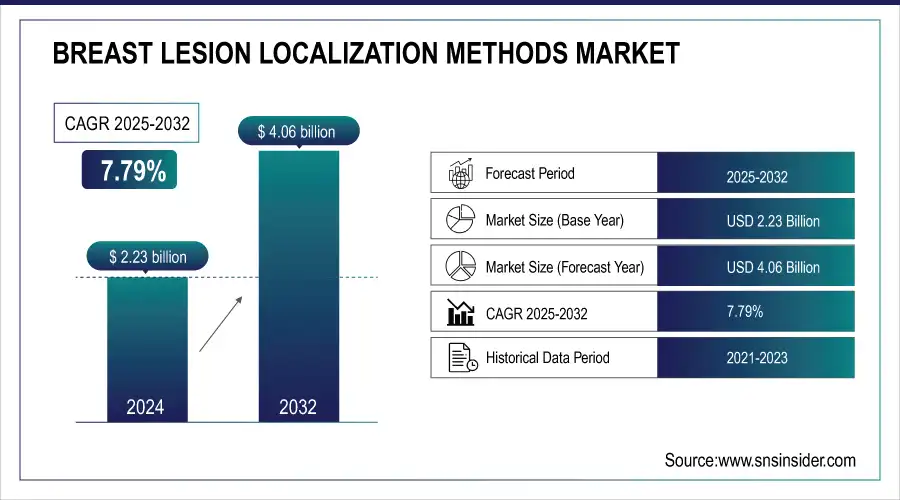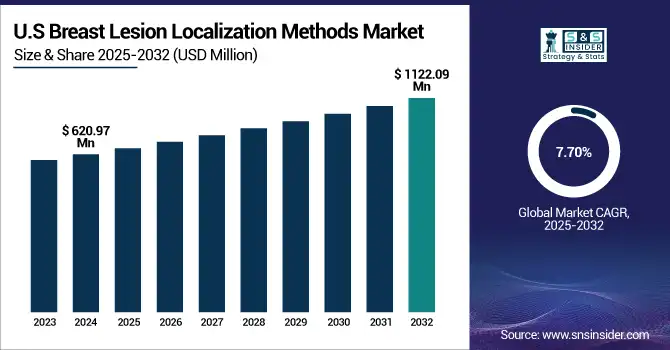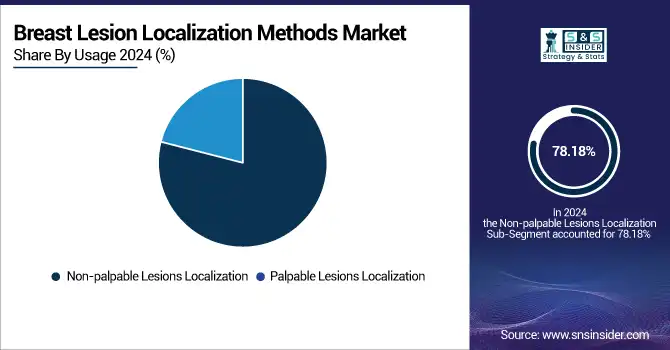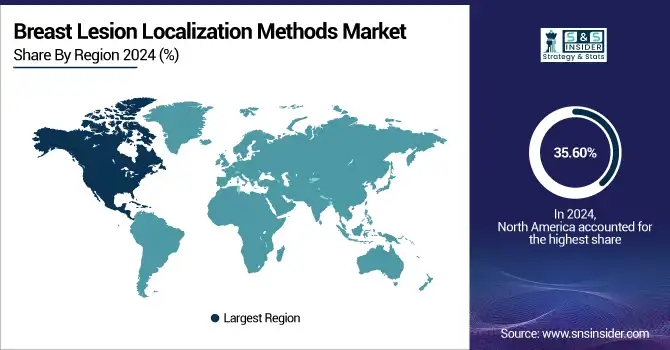Breast Lesion Localization Methods Market Report Scope & Overview:
The breast lesion localization methods market size was valued at USD 2.23 billion in 2024 and is expected to reach USD 4.06 billion by 2032, growing at a CAGR of 7.79% over the forecast period of 2025-2032.
The global breast lesion localization methods market is expected to witness growth on account of the increasing prevalence of breast cancer, which demands early detection and accurate surgical operation. With health systems focusing on precise, less invasive tests, Next-Gen Localization techniques are being used more regularly. It is only boosted by the advent of technology, including magnetic applications and AI imaging technologies. Key breast lesion localization methods market trends are currently migrating over invasive breast localization techniques during hospital stay to patient-friendly, outpatient procedures in an ambulatory setting.

To Get more information on Breast Lesion Localization Methods Market - Request Free Sample Report
For instance, in March 2025, the WHO reported that global breast cancer cases exceeded 2.6 million in 2024, driven by rising non-palpable lesion detection over expanded global screening programs.
The U.S. breast lesion localization methods market was valued at USD 620.97 million in 2024 and is expected to reach USD 1122.09 million by 2032, growing at a CAGR of 7.70% over 2025-2032.

The U.S. breast lesion localization methods market is currently leading, supported by well-established R&D infrastructure, higher private sector investment, and immediate translation of major technological novelty to clinical practice. New technologies, including magnetic seed and radar-oriented systems, are being developed and implemented at high speed. The U.S. has proven to be a fertile market for precise, patient-friendly localization solutions to launch and lead innovation, owing to its strong clinical validation base and early regulatory adoption.
For instance, in February 2025, U.S. R&D spending reached USD 880 billion in 2024, with medical device innovation, especially in breast lesion localization, growing 9%, reinforcing the U.S. market dominance.
Market Dynamics:
Drivers:
-
Improved Imaging Technologies, Driving the Breast Lesion Localization Methods Market Growth
Development of advanced imaging technologies is a major factor that drives the breast lesion localization methods market. It is possible to accurately detect NPLs due to high-resolution images, AI-based analysis, and rapid diagnosis. These innovations facilitate more accurate, less invasive, and patient-specific navigation, enhancing both surgical outcomes and patient care. Real-time, portable imaging is also now integrated, increasing access and efficiency and improving diagnosis and focused interventions for early-stage breast lesions in a variety of healthcare environments.
For instance, in January 2024, Frost & Sullivan reported an 18% growth in the global 3D/4D breast imaging market, with 40% of new systems integrating AI-assisted interpretation tools.
Restraints:
-
High Regulatory Hurdles are Restraining the Breast Lesion Localization Methods Market Growth
The high cost of equipment, procedures, and the limited access to healthcare infrastructure are the key restraints in the breast lesion localization methods market. While sophisticated technologies, including magnetic seed and radar-guided systems, can provide excellent detection, the need for a costly infrastructure prevents widespread implementation in small-scale operations and in emerging countries. These economic obstacles hinder the spread of innovations and deprive patients of access, subsequently affecting the breast lesion localization procedures market share.
For instance, in May 2025, GlobalData reported radar-based localization procedures cost 4x–5x more than wire localization, limiting adoption in rural and underserved clinics due to affordability issues.
Segmentation Analysis:
By Usage
In 2024, the Non-palpable Lesions Localization, dominated the breast lesion localization methods market with 78.18% share, and also emerged as the fastest growing segment in the market, driven by the rise in detecting early-stage breast lesions using advanced imaging modalities, including mammography, ultrasound, and MRI. These small, impalpable lesions must be accurately localized to be surgically removed. The trend toward minimally invasive procedures and wireless devices provides additional implications for the increasing use of accurate localization of non-palpable breast lesions in clinical practice.

By Type
Wire-guided localization was the dominant segment in the breast lesion localization methods market analysis, with a 35.94% market share in 2024, owing to its long tradition of clinical use and broad accessibility which is associated with lower expenses than for the more recently developed technologies. It remains a frequently used technique, and the preference continues to develop partly due to familiarity among surgeons and availability of facilities, especially in developing parts globally. These dynamics are crucially responsible for driving the breast lesion localization methods market growth.
Magnetic Tracer is emerging as the fastest-growing segment with a CAGR of 8.70% in the market over the forecast period, driven by its wireless, radiation-free technique, which increases the precision of surgery and causes less inconvenience to the patient. Ease of use, portability, and applicability to outpatient settings are among the leading factors. These benefits are driving the market for breast lesion localization methods market share.
By End-user
The Hospital segment dominates the global breast lesion localization methods industry with a significant market share of 60.40%. owing to the increase in the rate of diagnosis of breast cancer and increased participation in the screening of early, nonpalpable tumors. Accurate surgical planning and minimally invasive procedures are in demand for localization techniques, and thus, this segment is vital for efficient diagnosis and treatment within contemporary breast cancer care pathways.
In the breast lesion localization methods industry, the ambulatory surgical centers (ASCs) segment plays a vital role, registering the fastest growth over the forecast period, fueled by improved imaging and early diagnosis of non-palpable tumors. The growing inclination toward minimally invasive and wire-free procedures improve the accuracy of the surgeries and the patient experience. Increased awareness, organized screening, and technological developments are major factors promoting their adoption, which are among the cornerstones of contemporary, image-guided treatment approaches of breast cancer.
Regional Analysis:
In 2024, the North American region dominated the breast lesion localization methods industry and accounted for 35.60% of the overall revenue share. North America has a developed health system, a high incidence of breast cancer, and the use of advanced diagnostic technologies. The market in this region is backed by high R&D investments, a promising reimbursement scenario, and early introduction of wire-free and minimally invasive localization techniques, including radar-based and magnetic seed. There is also strong clinical adoption owing to leading market players and high awareness levels among patients and healthcare providers. Increasing frequent breast cancer screenings and the increasing emphasis on outpatient surgery will continue to ensure North America maintains its leading place globally.

Get Customized Report as per Your Business Requirement - Enquiry Now
Europe is the second leading market in the global breast lesion localization methods market as it has a strong healthcare system, a scope of national healthcare, and an increasing number of breast cancer incidences. Rising adoption of breast-conserving surgeries and increasing implementation of breast screening programmes are among the factors that are expected to contribute significantly to the growth of the localization technologies market in the future. Favorable regulatory and reimbursement fashions, a move toward non-radioactive and minimally invasive procedures, are also the initiatives undertaken are key factors for pushing the regional market growth.
The Asia Pacific region is projected to grow with the fastest CAGR of 8.42% over the forecast period, driven by increasing breast cancer occurrence, growing awareness, and expanding access to early detection and diagnostic facilities. Countries including China, India, Japan, and South Korea are focusing on expanding their healthcare infrastructure, screening programs, and public health campaigns to reduce the mounting cancer burden. Urbanization and growing incomes are also facilitating the adoption of sophisticated diagnostic tools, including wire-free or minimally invasive localization systems. Furthermore, the government backing, the burgeoning private healthcare industry, and cross-border partnerships have propelled the use of advanced localization methods. Due to an increase in use of these technologies by various hospitals and diagnostics centers, coupled with technological advancements in the clinical field, the Asia Pacific market is expanding at a significant rate and is anticipated to be the largest potential market during the forecast period.
The Middle East & Africa have the least market share in the breast lesion localization methods industry due to a lack of healthcare spending, high cost out-of-pocket, inadequate infrastructure, and a shortage of trained professionals. Economic imbalance and disjointed insurance systems also limit access to advanced technologies, which again, prevents large-scale adoption and scale of breast lesion localization technology on the continent.
The breast lesion localization methods market in Latin America has a modest market share owing to growing breast cancer awareness, growing screening programs, and rising healthcare infrastructure in Brazil, Mexico, and Argentina. But expansion is slowed by fluctuations in regional economies, disparities in access to health care, and the absence of reimbursement models. Notwithstanding these obstacles, government initiatives for cancer and an increase in the demand for minimally invasive surgeries have increased the adoption of advanced localization products in cities.
Key Players:
Breast lesion localization methods companies include Hologic, Inc., Becton, Dickinson and Company, Cianna Medical, Cook Medical, ICAD, Inc., Sirius Medical, Devicor Medical Products, Inc., Sirius Medical, Molli Surgical Inc., Biomedical Srl, and other players.
Recent Developments:
-
In April 2024, Sirius Medical received FDA clearance for the Pintuition 2.0 system, offering enhanced directional navigation and real-time feedback for magnetic lesion localization in breast-conserving surgeries.
-
In May 2024, Hologic launched an upgraded LOCalizer wire-free system with extended tag dwell time and enhanced ultrasound visibility, improving accuracy in non-palpable lesion localization and supporting breast-conserving surgery.
| Report Attributes | Details |
|---|---|
| Market Size in 2024 | USD 2.23 billion |
| Market Size by 2032 | USD 4.06 billion |
| CAGR | CAGR of 7.79% From 2025 to 2032 |
| Base Year | 2024 |
| Forecast Period | 2025-2032 |
| Historical Data | 2021-2023 |
| Report Scope & Coverage | Market Size, Segments Analysis, Competitive Landscape, Regional Analysis, DROC & SWOT Analysis, Forecast Outlook |
| Key Segments | "• By Type (Wire Guided Localization, Radioisotope Localization, Magnetic Tracer, Others) • By Usage (Non-palpable Lesions Localization, Palpable Lesions Localization) • By End User (Hospitals, Ambulatory Surgical Centers (ASCs), Specialty Clinics)" |
| Regional Analysis/Coverage | North America (US, Canada, Mexico), Europe (Germany, France, UK, Italy, Spain, Poland, Turkey, Rest of Europe), Asia Pacific (China, India, Japan, South Korea, Singapore, Australia, Rest of Asia Pacific), Middle East & Africa (UAE, Saudi Arabia, Qatar, South Africa, Rest of Middle East & Africa), Latin America (Brazil, Argentina, Rest of Latin America) |
| Company Profiles | Hologic, Inc. , Becton, Dickinson and Company, Cianna Medical, Cook Medical, ICAD, Inc., Sirius Medical, Devicor Medical Products, Inc., Sirius Medical, Molli Surgical Inc., Biomedical Srl and other players. |

